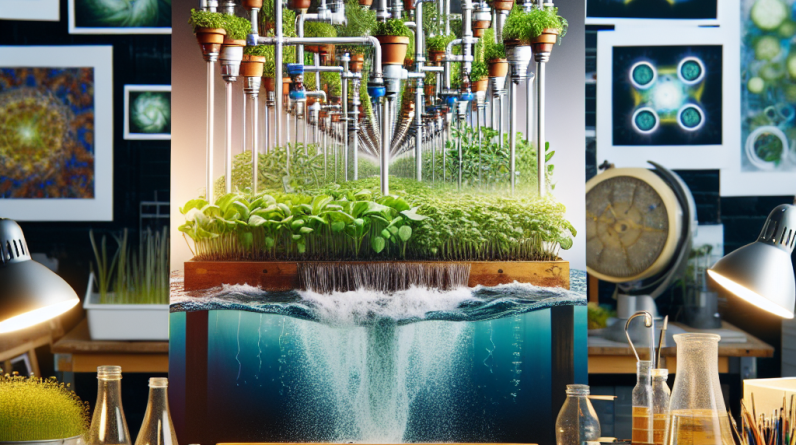
Understanding Hydroponic Systems
What is Hydroponics?
When I first stumbled upon hydroponics, it felt like I was entering a whole new world. Hydroponics is essentially the method of growing plants without soil, using nutrient-rich water instead. It’s fascinating to think about how plants can thrive without the traditional dirt we associate with gardening. This method provides a more controlled environment, allowing for greater efficiency and yields.
Hydroponic systems can vary in complexity, ranging from simple setups with a few plants to large-scale greenhouse operations. You can even grow everything from herbs to larger crops in these systems. I remember the first time I saw a hydroponic system in action; it was like being in a sci-fi movie where plants were growing in misty tubes.
The appeal lies not only in the innovative approach but also in the sustainability of it all. With water being a critical resource, hydroponic gardening can use up to 90% less water than traditional farming methods. It’s a win-win for both producers and the environment!
The Importance of Nutrient Management
Nutrient Solutions
One of the most critical aspects that I’ve learned about hydroponic gardening is managing nutrient solutions. Plants require specific nutrients like nitrogen, phosphorus, and potassium, among others, and these need to be provided in precise quantities. I often find myself tweaking the solutions to get them just right!
The pH and electrical conductivity of your nutrient solutions are key indicators of how well your plants will thrive. For instance, if the pH is too high or too low, plants can’t absorb essential nutrients. It’s like throwing a party and forgetting to invite the plant nutrients!
Over time, I’ve developed a bit of a routine. I check the nutrient solution frequently and adjust it depending on the plant species I’m growing. It sounds tedious, but once you’ve hammered down the basics, it becomes second nature.
Choosing the Right Hydroponic System
Types of Hydroponic Systems
Ah, choosing the right hydroponic system—a topic that I could talk about for hours! There are several types, and each has its pros and cons. I personally started with a Deep Water Culture (DWC) system because it seemed straightforward and less intimidating. Basically, the roots are suspended in nutrient-rich water, providing quick access to nutrients.
As I got more comfortable, I decided to expand my horizons and try Nutrient Film Technique (NFT) and Ebb and Flow systems. Each system has its learning curve, but experimenting has allowed me to find what works best for me and my space.
What I love about hydroponics is that there’s no one-size-fits-all approach. Depending on the space you have and the plants you want to grow, some systems might be more suitable than others. Don’t be afraid to experiment and find the system that really resonates with you!
Environmental Factors to Consider
Light Requirements
Lighting is often an overlooked aspect of hydroponic design, but trust me—it’s a big deal! I initially relied on natural sunlight, and while it’s fantastic, it can be unpredictable. That’s when I decided to invest in grow lights, and wow, what a difference they made!
Different plants have varying light requirements, so it’s crucial to do some homework before diving in. Some plants thrive with lower light exposure, while others need bright, direct light to flourish. I’ve lost my fair share of seedlings because I underestimated their lighting needs.
Creating an optimal lighting setup means understanding your specific plants and adjusting accordingly. It’s about giving your hydroponic babies the love they need to reach their full potential!
Maintaining Your Hydroponic Garden
Regular Monitoring
Once your hydroponic garden is up and running, the fun doesn’t stop there—maintenance becomes key! I can’t emphasize enough how important it is to regularly monitor your plants’ health. This includes checking for pests, diseases, and ensuring your nutrient solution remains balanced.
Having a routine that includes regular inspections helps catch problems early, and I can’t tell you how many headaches it has saved me. Instead of a systemic issue later on, I can fix small problems before they escalate.
Learning as I go has also helped me become more intuitive with plant care. You’ll start to notice signs that your plants need adjustments—like yellowing leaves or stunted growth. These little cues make maintaining a hydroponic system a rewarding adventure!
Frequently Asked Questions
1. What is hydroponics?
Hydroponics is a method of growing plants in nutrient-rich water without soil. It allows for more controlled growing conditions and can lead to higher yields and water efficiency.
2. How do I manage nutrient solutions?
To manage nutrient solutions, regularly monitor the pH and electrical conductivity, and adjust based on the needs of the crops you are growing. It takes a bit of practice, but you’ll get the hang of it!
3. What type of hydroponic system should I start with?
Begin with a simpler system like Deep Water Culture (DWC) or a basic Ebb and Flow setup. As you gain experience, you can try more complex systems!
4. How important is lighting in hydroponics?
Lighting is crucial! Plants have specific light requirements that need to be met for optimal growth. Consider using grow lights, especially if natural light is limited.
5. What are some key maintenance tips for hydroponic gardening?
Regularly monitor the health of your plants, check for pests and diseases, and ensure your nutrient solution is balanced. Creating a maintenance routine helps prevent bigger issues down the line.







